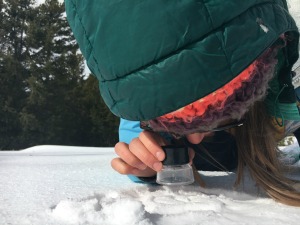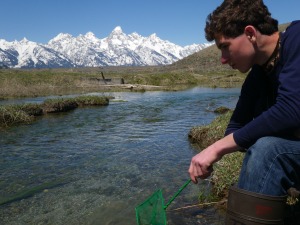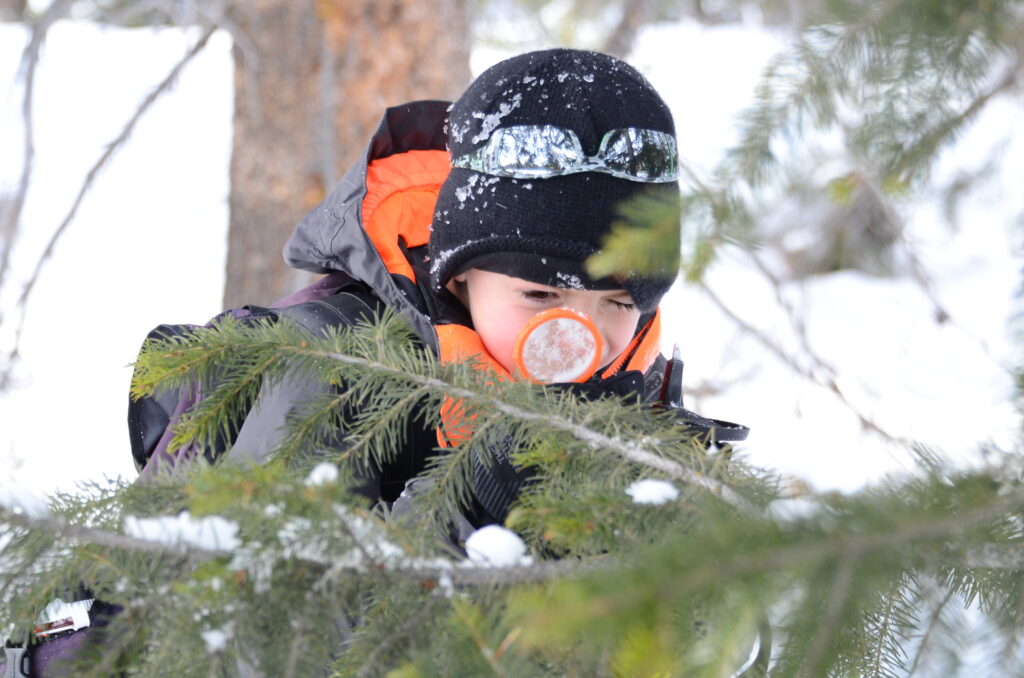
The phrase “connection to place” is in every lesson plan and weekly schedule that Teton Science Schools field instructors have ever read or written. We are tasked with instilling that concept in our students through observation and scientific investigations, through leadership initiatives and journal reflections. If the tears, hugs, and evaluations on students’ departure days are any indication, then we certainly do a good job. But do we really know what it means for a student to actually “connect to place?”
 I’ve heard various attempts to define this intangible concept from TSS staff, all of them eloquent and relevant to what we do. For me, connection to place means helping students form an emotional bond with their surroundings. For others, it is providing an understanding of the historical and ecological context that makes a place unique. Some see it as an ability to draw similarities between “this place” and a student’s home ecosystem. Surely, “connection to place” is all of these things and more—such a broad definition makes it easy to thread this concept throughout all that we do in field education. Yet, at the end of all my field weeks, I have found myself unsure of exactly what to look for in students to assess whether they have, in fact, connected to this place.
I’ve heard various attempts to define this intangible concept from TSS staff, all of them eloquent and relevant to what we do. For me, connection to place means helping students form an emotional bond with their surroundings. For others, it is providing an understanding of the historical and ecological context that makes a place unique. Some see it as an ability to draw similarities between “this place” and a student’s home ecosystem. Surely, “connection to place” is all of these things and more—such a broad definition makes it easy to thread this concept throughout all that we do in field education. Yet, at the end of all my field weeks, I have found myself unsure of exactly what to look for in students to assess whether they have, in fact, connected to this place.
This winter, I’ve been able to explore what “connection to place” means to me, not from the perspective of an educator, but as a learner. In December I had the chance to simulate the immersive TSS student experience during an independent week-long trip to Guatemala. By the second night, my trip brought me 12,000 feet above sea level, to the slopes of Acatenanga, the third tallest volcano in Central America, and a spot ripe for comparisons between the tropical montane ecosystem of Guatemala and the sagebrush flats of northwestern Wyoming.
 At first, it was the differences between the two ecosystems that struck me. As I ascended the volcanic slopes, I passed through a mid-mountain cloud forest—a micro-biome notable for its “cloud-stripping” ability, in which the forest feeds moisture to the soil and watershed by absorbing it from the sky. As if that’s not impressive enough, the biodiversity of the cloud forest was beyond enchanting. Almost without even realizing, I found myself jotting down observations of flowers and insects that seemed to have been engineered by a mad scientist. Compared with the mere fourteen or so tree species that live in the cold and dry Greater Yellowstone Ecosystem, the tropical climate of the cloud forest contained more than I could possibly count. One observation I recorded was of “four or five different small trees growing out of one branch on a larger tree.” I could have spent weeks in the cloud forest using the “I notice, I wonder, it reminds me of” observation tools that we teach TSS students. My curiosity was expanding by the second; the abundance of life was truly a spectacle.
At first, it was the differences between the two ecosystems that struck me. As I ascended the volcanic slopes, I passed through a mid-mountain cloud forest—a micro-biome notable for its “cloud-stripping” ability, in which the forest feeds moisture to the soil and watershed by absorbing it from the sky. As if that’s not impressive enough, the biodiversity of the cloud forest was beyond enchanting. Almost without even realizing, I found myself jotting down observations of flowers and insects that seemed to have been engineered by a mad scientist. Compared with the mere fourteen or so tree species that live in the cold and dry Greater Yellowstone Ecosystem, the tropical climate of the cloud forest contained more than I could possibly count. One observation I recorded was of “four or five different small trees growing out of one branch on a larger tree.” I could have spent weeks in the cloud forest using the “I notice, I wonder, it reminds me of” observation tools that we teach TSS students. My curiosity was expanding by the second; the abundance of life was truly a spectacle.
Yet just when I had concluded that Guatemala couldn’t be any more different than the GYE, we entered the alpine zone of the volcano, and I was confronted with unexpected familiarity. A sea of deceased pine trees lay between us and the summit; a Parque Nacional exhibit informed me that the perpetrator of the conifer carnage was none other than the mountain pine beetle, the same pest that has been ravaging lodgepole and whitebark pines across the Rocky Mountains. Despite my sorrow at the pervasiveness of the beetle problem, I was elated to have encountered a phenomenon that I regularly teach about at home. Soon, I discovered that the hillsides surrounding the forest were adorned with lupine, aster, and paintbrush, all wildflowers that are commonly encountered during summers in Jackson Hole, and I was immediately brought back to my time hiking the crest of the Tetons. The similarities were both curious and comforting. I legitimately felt closer to the Guatemalan ecosystem simply by drawing significant connections to my own.
 Perhaps the most breathtaking experience of the entire trip was watching Volcán Fuego erupt plumes of ash and lava as the sun set behind it, and feeling the eerie rumble of those eruptions beneath me as I slept. Watching as the tower of ash reflected the orange glow of dusk, I was overcome by awe at the violent and magnificent show of power. While the experience of seeing a volcano erupt was entirely new to me, I couldn’t help but think about the first time I saw the geysers of Yellowstone, for the feeling was the same: total respect. While the diversity of the new environment galvanized my inner scientist, the natural forces common to both Guatemala and Wyoming made me feel intimate with an unfamiliar place, made me care about it as if it were my home. I felt grateful for the privilege of knowing these two places deeply, but even more grateful that other people, like me, wanted to protect them.
Perhaps the most breathtaking experience of the entire trip was watching Volcán Fuego erupt plumes of ash and lava as the sun set behind it, and feeling the eerie rumble of those eruptions beneath me as I slept. Watching as the tower of ash reflected the orange glow of dusk, I was overcome by awe at the violent and magnificent show of power. While the experience of seeing a volcano erupt was entirely new to me, I couldn’t help but think about the first time I saw the geysers of Yellowstone, for the feeling was the same: total respect. While the diversity of the new environment galvanized my inner scientist, the natural forces common to both Guatemala and Wyoming made me feel intimate with an unfamiliar place, made me care about it as if it were my home. I felt grateful for the privilege of knowing these two places deeply, but even more grateful that other people, like me, wanted to protect them.
 “Connecting to place” wasn’t by any means the purpose of my trip; it simply happened that way. But that is also the beauty of it: I didn’t have to consciously try and connect with my surroundings, for it was my natural inclination to observe, ask questions, and look for patterns because that’s what I have been taught at TSS. These tools have become habits, and I became connected to the Guatemalan ecosystem simply by using them. As I prepare to begin teaching again back in Jackson, I reflect on what it means to cultivate “connection to place” in my students, and I’ve realized what is perhaps more important than defining the term itself: it isn’t necessarily about helping students connect to this place, but showing them how to connect to any place. All we can hope to do in the span of a week is provide them with tools and plant a seed, as TSS has done for me.
“Connecting to place” wasn’t by any means the purpose of my trip; it simply happened that way. But that is also the beauty of it: I didn’t have to consciously try and connect with my surroundings, for it was my natural inclination to observe, ask questions, and look for patterns because that’s what I have been taught at TSS. These tools have become habits, and I became connected to the Guatemalan ecosystem simply by using them. As I prepare to begin teaching again back in Jackson, I reflect on what it means to cultivate “connection to place” in my students, and I’ve realized what is perhaps more important than defining the term itself: it isn’t necessarily about helping students connect to this place, but showing them how to connect to any place. All we can hope to do in the span of a week is provide them with tools and plant a seed, as TSS has done for me.
If I were forced to define “connection to place” in some way, however, I would defer to naturalist John Muir Laws, who says that “a useful definition of love is sustained compassionate attention.” I have found evidence to support that claim through all my experiences in nature, including the Guatemalan ecosystem. But perhaps more importantly, I have found that this principle extends beyond the natural world. Even as I left the mountains of Guatemala, I found myself falling in love with the culture, the people, and the crowded public buses, simply because I gave those things my sustained compassionate attention. Every time my students leave TSS, I feel a nervous hopefulness that they will use what they learned here. That perhaps the next time they pick up a leaf, or stare at the mountains, or go someplace new, or meet someone different, they will show some sustained compassionate attention, and care a little deeper.

Editor’s Note: You will, by now, have noticed that none of these photos were taken in Central America. Our author was so busy connecting to place, that he did not take any photos. Instead, these photos highlight TSS students showing “sustained compassionate attention,” in many different forms, during Field Education experiences in the Greater Yellowstone Ecosystem.


